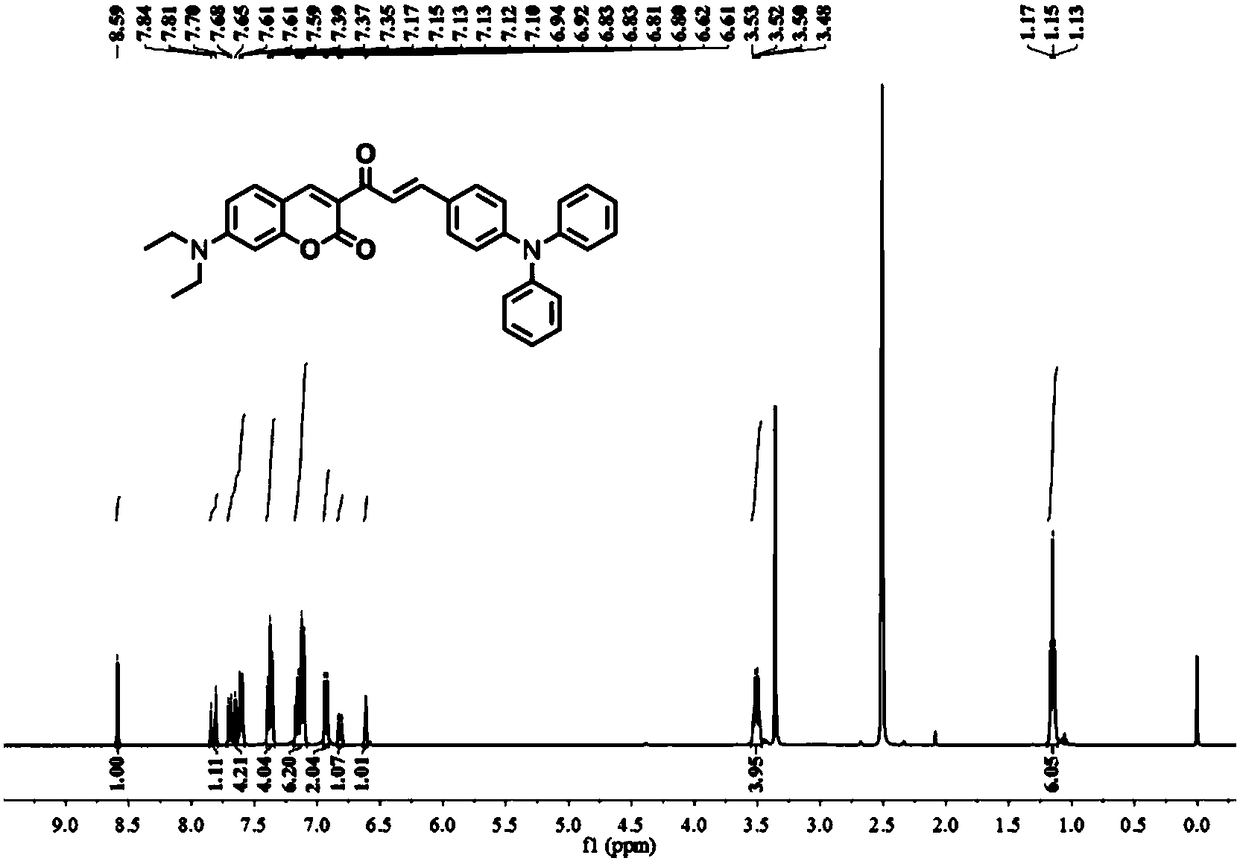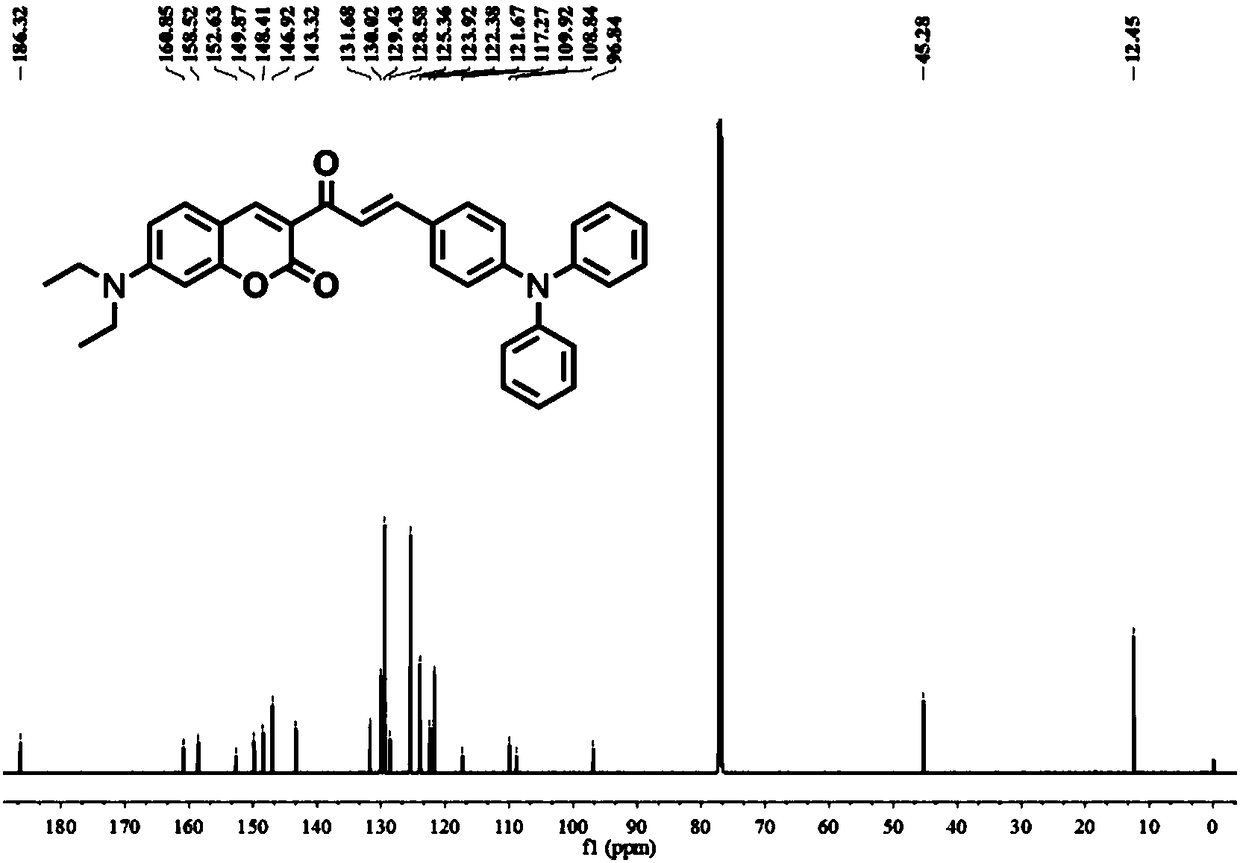Ratio type fluorescent probe for distinguishing lipid droplets with different polarities as well as preparation method and application thereof
A technology for fluorescent probes and polar lipids, applied in fluorescence/phosphorescence, chemical instruments and methods, analytical materials, etc., can solve the problem of inability to distinguish lipid droplets of different polarities, achieve good polarity-specific response, and purify Convenience and high yield
- Summary
- Abstract
- Description
- Claims
- Application Information
AI Technical Summary
Problems solved by technology
Method used
Image
Examples
Embodiment 1
[0035] Example 1 Synthesis of Fluorescent Probe CTPA
[0036] (1) Synthesis of compound (3):
[0037]
[0038] Add 1.93 g of NN-diethylamino salicylaldehyde (10 mmol) (1) and 1.56 g of ethyl acetoacetate (12 mmol) into a flask filled with 20 mL of ethanol, after stirring evenly, add three drops of piperidine at room temperature After stirring overnight, a large amount of yellow solids precipitated, filtered, washed with ethanol, added 90°C ethanol until just dissolved, recrystallized after cooling, and proceeded to the next step of reaction.
[0039] (2) Synthesis of compound (5):
[0040]
[0041] Weigh 0.59 g 3-acetyl-7 (diethylamino) coumarin (3) (1 mmol), add dropwise three drops of piperidine, and 0.273 g 4-dianilinobenzaldehyde (1 mmol) in the Compound (4) in a mixture of ethanol and acetonitrile (1:1), heated to 80 °C and refluxed overnight, a solid precipitated, filtered under reduced pressure, and recrystallized with a mixture of ethanol and acetonitrile to ob...
Embodiment 2
[0045] Example 2 Emission spectra of fluorescent probes in different solvents
[0046]A test mother solution of the fluorescent probe CTPA synthesized in Example 1 in dimethyl sulfoxide (DMSO) with a concentration of 1 mM was prepared for use.
[0047] In the test solution, take 3 mL solvents of different polarities: dioxane, ether, tetrahydrofuran (THF), dichloromethane (DCM), butanol, acetone, dimethyl sulfoxide (DMSO), and then add 30 μL of the probe mother solution, so that the concentration of the probe in the test solution is 10 μL, and perform fluorescence scanning (excitation wavelength 455nm, detection band 450-750nm). The fluorescence intensity in each system was obtained. Such as Figure 4 As shown, as the solvent polarity increases, the spectrum red shifts and the fluorescence intensity becomes weaker.
Embodiment 3
[0048] Example 3 Selectivity of Fluorescent Probes to Different Molecules or Ions
[0049] A test mother solution of the fluorescent probe CTPA synthesized in Example 1 in dimethyl sulfoxide (DMSO) with a concentration of 1 mM was prepared for use. Prepare Fe at a concentration of 200 μM 2+ , H 2 o 2 , Gys, Gin, GSH, Ser, Thr, Asn, ClO - , Dioxane solution, set aside.
[0050] Add 30 μL of probe mother solution to 3 mL of the solution prepared above to ensure that the final concentration of the solution to be tested is 10 μM, then shake well, and perform emission spectrum detection (excitation wavelength 455nm, detection band 450-750nm). The ratio of the measured fluorescence intensity to the fluorescence intensity of dioxane (I / I 二氧六环 ) is the ordinate, and different molecules or ions are used as the abscissa to make a histogram, such as Figure 5 . Depend on Figure 5 It can be seen that the fluorescent probe has strong fluorescence in dioxane solution; the fluoresce...
PUM
 Login to View More
Login to View More Abstract
Description
Claims
Application Information
 Login to View More
Login to View More - R&D
- Intellectual Property
- Life Sciences
- Materials
- Tech Scout
- Unparalleled Data Quality
- Higher Quality Content
- 60% Fewer Hallucinations
Browse by: Latest US Patents, China's latest patents, Technical Efficacy Thesaurus, Application Domain, Technology Topic, Popular Technical Reports.
© 2025 PatSnap. All rights reserved.Legal|Privacy policy|Modern Slavery Act Transparency Statement|Sitemap|About US| Contact US: help@patsnap.com



